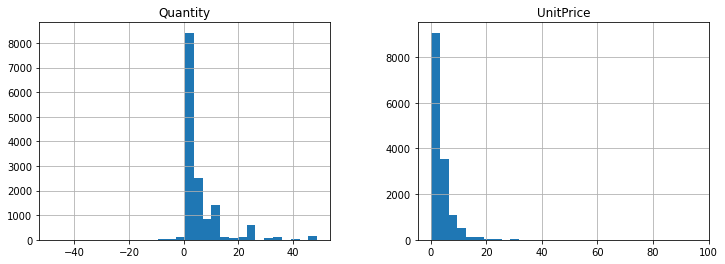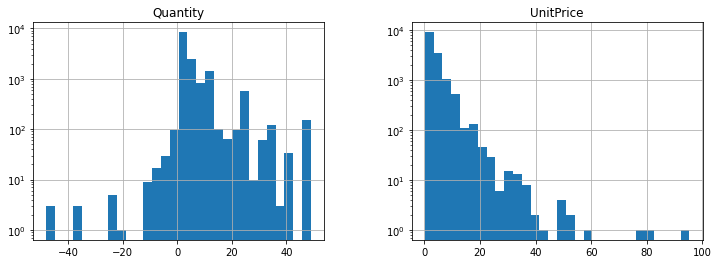Demo Notebook for Online Retail Analysis
download notebook
Step 0: Imports
[2]:
%load_ext autoreload
%autoreload 2
[3]:
# import this to stop opensearch-py-ml from yelling every time a DataFrame connection made
import warnings
warnings.filterwarnings('ignore')
[4]:
# imports to demonstrate DataFrame support
import pandas as pd
import numpy as np
import matplotlib.pyplot as plt
import opensearch_py_ml as oml
from opensearchpy import OpenSearch
# Import standard test settings for consistent results
from opensearch_py_ml.conftest import *
Step 1: Setup clients
[6]:
CLUSTER_URL = 'https://localhost:9200'
def get_os_client(cluster_url = CLUSTER_URL,
username='admin',
password='< admin password >'):
'''
Get OpenSearch client
:param cluster_url: cluster URL like https://ml-te-netwo-1s12ba42br23v-ff1736fa7db98ff2.elb.us-west-2.amazonaws.com:443
:return: OpenSearch client
'''
client = OpenSearch(
hosts=[cluster_url],
http_auth=(username, password),
verify_certs=False
)
return client
[7]:
client = get_os_client()
Getting Started
To get started, let’s create an opensearch_py_ml.DataFrame by reading a csv file. This creates and populates the online-retail index in the local Opensearch cluster.
[11]:
df = oml.csv_to_opensearch("data/online-retail.csv.gz",
os_client=client,
os_dest_index='online-retail',
es_if_exists='replace',
os_dropna=True,
es_refresh=True,
compression='gzip',
index_col=0)
Here we see that the "_id" field was used to index our data frame.
[13]:
df.index.os_index_field
[13]:
'_id'
Next, we can check which field from opensearch are available to our opensearch_py_ml data frame. columns is available as a parameter when instantiating the data frame which allows one to choose only a subset of fields from your index to be included in the data frame. Since we didn’t set this parameter, we have access to all fields.
[14]:
df.columns
[14]:
Index(['Country', 'CustomerID', 'Description', 'InvoiceDate', 'InvoiceNo', 'Quantity', 'StockCode',
'UnitPrice'],
dtype='object')
Now, let’s see the data types of our fields. Running df.dtypes, we can see that opensearch field types are mapped to pandas field types.
[15]:
df.dtypes
[15]:
Country object
CustomerID float64
Description object
InvoiceDate object
InvoiceNo object
Quantity int64
StockCode object
UnitPrice float64
dtype: object
We also offer a .os_info() data frame method that shows all info about the underlying index. It also contains information about operations being passed from data frame methods to opensearch. More on this later.
[16]:
print(df.os_info())
os_index_pattern: online-retail
Index:
os_index_field: _id
is_source_field: False
Mappings:
capabilities:
os_field_name is_source os_dtype os_date_format pd_dtype is_searchable is_aggregatable is_scripted aggregatable_os_field_name
Country Country True keyword None object True True False Country
CustomerID CustomerID True double None float64 True True False CustomerID
Description Description True keyword None object True True False Description
InvoiceDate InvoiceDate True keyword None object True True False InvoiceDate
InvoiceNo InvoiceNo True keyword None object True True False InvoiceNo
Quantity Quantity True long None int64 True True False Quantity
StockCode StockCode True keyword None object True True False StockCode
UnitPrice UnitPrice True double None float64 True True False UnitPrice
Operations:
tasks: []
size: None
sort_params: None
_source: ['Country', 'CustomerID', 'Description', 'InvoiceDate', 'InvoiceNo', 'Quantity', 'StockCode', 'UnitPrice']
body: {}
post_processing: []
Selecting and Indexing Data
Now that we understand how to create a data frame and get access to it’s underlying attributes, let’s see how we can select subsets of our data.
head and tail
much like pandas, opensearch_py_ml data frames offer .head(n) and .tail(n) methods that return the first and last n rows, respectively.
[17]:
df.head(2)
[17]:
| Country | CustomerID | ... | StockCode | UnitPrice | |
|---|---|---|---|---|---|
| 0 | United Kingdom | 17850.0 | ... | 85123A | 2.55 |
| 1 | United Kingdom | 17850.0 | ... | 71053 | 3.39 |
2 rows × 8 columns
[18]:
print(df.tail(2).head(2).tail(2).os_info())
os_index_pattern: online-retail
Index:
os_index_field: _id
is_source_field: False
Mappings:
capabilities:
os_field_name is_source os_dtype os_date_format pd_dtype is_searchable is_aggregatable is_scripted aggregatable_os_field_name
Country Country True keyword None object True True False Country
CustomerID CustomerID True double None float64 True True False CustomerID
Description Description True keyword None object True True False Description
InvoiceDate InvoiceDate True keyword None object True True False InvoiceDate
InvoiceNo InvoiceNo True keyword None object True True False InvoiceNo
Quantity Quantity True long None int64 True True False Quantity
StockCode StockCode True keyword None object True True False StockCode
UnitPrice UnitPrice True double None float64 True True False UnitPrice
Operations:
tasks: [('tail': ('sort_field': '_doc', 'count': 2)), ('head': ('sort_field': '_doc', 'count': 2)), ('tail': ('sort_field': '_doc', 'count': 2))]
size: 2
sort_params: {'_doc': 'desc'}
_source: ['Country', 'CustomerID', 'Description', 'InvoiceDate', 'InvoiceNo', 'Quantity', 'StockCode', 'UnitPrice']
body: {}
post_processing: [('sort_index'), ('head': ('count': 2)), ('tail': ('count': 2))]
[19]:
df.tail(2)
[19]:
| Country | CustomerID | ... | StockCode | UnitPrice | |
|---|---|---|---|---|---|
| 14998 | United Kingdom | 17419.0 | ... | 21773 | 1.25 |
| 14999 | United Kingdom | 17419.0 | ... | 22149 | 2.10 |
2 rows × 8 columns
Selecting columns
you can also pass a list of columns to select columns from the data frame in a specified order.
[20]:
df[['Country', 'InvoiceDate']].head(5)
[20]:
| Country | InvoiceDate | |
|---|---|---|
| 0 | United Kingdom | 2010-12-01 08:26:00 |
| 1 | United Kingdom | 2010-12-01 08:26:00 |
| 2 | United Kingdom | 2010-12-01 08:26:00 |
| 3 | United Kingdom | 2010-12-01 08:26:00 |
| 4 | United Kingdom | 2010-12-01 08:26:00 |
5 rows × 2 columns
Boolean Indexing
we also allow you to filter the data frame using boolean indexing. Under the hood, a boolean index maps to a terms query that is then passed to opensearch to filter the index.
[21]:
# the construction of a boolean vector maps directly to an opensearch query
print(df['Country']=='Germany')
df[(df['Country']=='Germany')].head(5)
{'term': {'Country': 'Germany'}}
[21]:
| Country | CustomerID | ... | StockCode | UnitPrice | |
|---|---|---|---|---|---|
| 1109 | Germany | 12662.0 | ... | 22809 | 2.95 |
| 1110 | Germany | 12662.0 | ... | 84347 | 2.55 |
| 1111 | Germany | 12662.0 | ... | 84945 | 0.85 |
| 1112 | Germany | 12662.0 | ... | 22242 | 1.65 |
| 1113 | Germany | 12662.0 | ... | 22244 | 1.95 |
5 rows × 8 columns
we can also filter the data frame using a list of values.
[22]:
print(df['Country'].isin(['Germany', 'United States']))
df[df['Country'].isin(['Germany', 'United Kingdom'])].head(5)
{'terms': {'Country': ['Germany', 'United States']}}
[22]:
| Country | CustomerID | ... | StockCode | UnitPrice | |
|---|---|---|---|---|---|
| 0 | United Kingdom | 17850.0 | ... | 85123A | 2.55 |
| 1 | United Kingdom | 17850.0 | ... | 71053 | 3.39 |
| 2 | United Kingdom | 17850.0 | ... | 84406B | 2.75 |
| 3 | United Kingdom | 17850.0 | ... | 84029G | 3.39 |
| 4 | United Kingdom | 17850.0 | ... | 84029E | 3.39 |
5 rows × 8 columns
We can also combine boolean vectors to further filter the data frame.
[23]:
df[(df['Country']=='Germany') & (df['Quantity']>90)]
[23]:
| Country | CustomerID | ... | StockCode | UnitPrice |
|---|
0 rows × 8 columns
Using this example, let see how opensearch_py_ml translates this boolean filter to an opensearch bool query.
[24]:
print(df[(df['Country']=='Germany') & (df['Quantity']>90)].os_info())
os_index_pattern: online-retail
Index:
os_index_field: _id
is_source_field: False
Mappings:
capabilities:
os_field_name is_source os_dtype os_date_format pd_dtype is_searchable is_aggregatable is_scripted aggregatable_os_field_name
Country Country True keyword None object True True False Country
CustomerID CustomerID True double None float64 True True False CustomerID
Description Description True keyword None object True True False Description
InvoiceDate InvoiceDate True keyword None object True True False InvoiceDate
InvoiceNo InvoiceNo True keyword None object True True False InvoiceNo
Quantity Quantity True long None int64 True True False Quantity
StockCode StockCode True keyword None object True True False StockCode
UnitPrice UnitPrice True double None float64 True True False UnitPrice
Operations:
tasks: [('boolean_filter': ('boolean_filter': {'bool': {'must': [{'term': {'Country': 'Germany'}}, {'range': {'Quantity': {'gt': 90}}}]}}))]
size: None
sort_params: None
_source: ['Country', 'CustomerID', 'Description', 'InvoiceDate', 'InvoiceNo', 'Quantity', 'StockCode', 'UnitPrice']
body: {'query': {'bool': {'must': [{'term': {'Country': 'Germany'}}, {'range': {'Quantity': {'gt': 90}}}]}}}
post_processing: []
Aggregation and Descriptive Statistics
Let’s begin to ask some questions of our data and use opensearch_py_ml to get the answers.
How many different countries are there?
[25]:
df['Country'].nunique()
[25]:
16
What is the total sum of products ordered?
[26]:
df['Quantity'].sum()
[26]:
111960
Show me the sum, mean, min, and max of the qunatity and unit_price fields
[27]:
df[['Quantity','UnitPrice']].agg(['sum', 'mean', 'max', 'min'])
[27]:
| Quantity | UnitPrice | |
|---|---|---|
| sum | 111960.000 | 61548.490000 |
| mean | 7.464 | 4.103233 |
| max | 2880.000 | 950.990000 |
| min | -9360.000 | 0.000000 |
Give me descriptive statistics for the entire data frame
[28]:
# NBVAL_IGNORE_OUTPUT
df.describe()
[28]:
| CustomerID | Quantity | UnitPrice | |
|---|---|---|---|
| count | 10729.000000 | 15000.000000 | 15000.000000 |
| mean | 15590.776680 | 7.464000 | 4.103233 |
| std | 1764.189592 | 85.930116 | 20.106214 |
| min | 12347.000000 | -9360.000000 | 0.000000 |
| 25% | 14222.689466 | 1.000000 | 1.250000 |
| 50% | 15668.019608 | 2.000000 | 2.510000 |
| 75% | 17218.806604 | 6.472000 | 4.212788 |
| max | 18239.000000 | 2880.000000 | 950.990000 |
Show me a histogram of numeric columns
[29]:
df[(df['Quantity']>-50) &
(df['Quantity']<50) &
(df['UnitPrice']>0) &
(df['UnitPrice']<100)][['Quantity', 'UnitPrice']].hist(figsize=[12,4], bins=30)
plt.show()

[30]:
df[(df['Quantity']>-50) &
(df['Quantity']<50) &
(df['UnitPrice']>0) &
(df['UnitPrice']<100)][['Quantity', 'UnitPrice']].hist(figsize=[12,4], bins=30, log=True)
plt.show()

[31]:
df.query('Quantity>50 & UnitPrice<100')
[31]:
| Country | CustomerID | ... | StockCode | UnitPrice | |
|---|---|---|---|---|---|
| 46 | United Kingdom | 13748.0 | ... | 22086 | 2.55 |
| 83 | United Kingdom | 15291.0 | ... | 21733 | 2.55 |
| 96 | United Kingdom | 14688.0 | ... | 21212 | 0.42 |
| 102 | United Kingdom | 14688.0 | ... | 85071B | 0.38 |
| 176 | United Kingdom | 16029.0 | ... | 85099C | 1.65 |
| ... | ... | ... | ... | ... | ... |
| 14784 | United Kingdom | 15061.0 | ... | 22423 | 10.95 |
| 14785 | United Kingdom | 15061.0 | ... | 22075 | 1.45 |
| 14788 | United Kingdom | 15061.0 | ... | 17038 | 0.07 |
| 14974 | United Kingdom | 14739.0 | ... | 21704 | 0.72 |
| 14980 | United Kingdom | 14739.0 | ... | 22178 | 1.06 |
258 rows × 8 columns
Arithmetic Operations
Numeric values
[32]:
df['Quantity'].head()
[32]:
0 6
1 6
2 8
3 6
4 6
Name: Quantity, dtype: int64
[33]:
df['UnitPrice'].head()
[33]:
0 2.55
1 3.39
2 2.75
3 3.39
4 3.39
Name: UnitPrice, dtype: float64
[34]:
product = df['Quantity'] * df['UnitPrice']
[35]:
product.head()
[35]:
0 15.30
1 20.34
2 22.00
3 20.34
4 20.34
dtype: float64
String concatenation
[36]:
df['Country'] + df['StockCode']
[36]:
0 United Kingdom85123A
1 United Kingdom71053
2 United Kingdom84406B
3 United Kingdom84029G
4 United Kingdom84029E
...
14995 United Kingdom72349B
14996 United Kingdom72741
14997 United Kingdom22762
14998 United Kingdom21773
14999 United Kingdom22149
Length: 15000, dtype: object
[ ]: